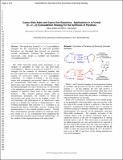Cyano Diels-Alder and Cyano Ene Reactions. Applications in a Formal [2 + 2 + 2] Cycloaddition Strategy for the Synthesis of Pyridines
Author(s)
Sakai, Takeo; Danheiser, Rick Lane
DownloadDanheiser Revised Text JACS 2010 132 13203.pdf (119.1Kb)
PUBLISHER_POLICY
Publisher Policy
Article is made available in accordance with the publisher's policy and may be subject to US copyright law. Please refer to the publisher's site for terms of use.
Terms of use
Metadata
Show full item recordAbstract
Two metal-free, formal [2 + 2 + 2] cycloaddition strategies for the construction of polycyclic pyridine derivatives are described that proceed via pericyclic cascade mechanisms featuring the participation of unactivated cyano groups as enophile and dienophile cycloaddition partners.
The nitrile functional group rarely participates as an enophile or dienophile in Alder ene and Diels−Alder cycloadditions.(1, 2) Herein we describe two formal [2 + 2 + 2] strategies for the synthesis of substituted pyridines that proceed via pericyclic cascade processes involving the unusual reaction of unactivated nitriles as 2-π cycloaddition components. As outlined in Scheme 1, the first strategy begins with a propargylic ene reaction(3) which is followed by an intramolecular Diels−Alder reaction in which an unactivated cyano group functions as the dienophile. When the initial propargylic ene step is blocked (e.g., by substitution at the appropriate propargylic carbon), then a second cascade sequence is operative which leads to the same pyridine products. This alternate pathway begins with an intramolecular propargylic ene reaction in which an unactivated cyano group serves as the enophilic π-bond. To our knowledge, the participation of an unactivated cyano group in a thermal ene reaction is unprecedented.(4, 5) The resulting allenylimine then functions as a 1-azadiene in an intramolecular hetero Diels−Alder reaction(6) leading (after tautomerization) to the isolated pyridine product. Overall, these transformations provide strategies for achieving metal-free, formal [2 + 2 + 2] cycloadditions(7) that complement the well established transition-metal-catalyzed methodology(8) for the synthesis of this important heterocyclic ring system.
Date issued
2010-09Department
Massachusetts Institute of Technology. Department of ChemistryJournal
Journal of the American Chemical Society
Publisher
American Chemical Society
Citation
Sakai, Takeo, and Rick L. Danheiser. “Cyano Diels−Alder and Cyano Ene Reactions. Applications in a Formal [2 + 2 + 2] Cycloaddition Strategy for the Synthesis of Pyridines.” Journal of the American Chemical Society 132.38 (2010): 13203-13205.
Version: Author's final manuscript
ISSN
0002-7863
1520-5126